After announcing he took a 9.2% stake in Twitter a few weeks ago, Elon Musk surprised investors by offering the buy Twitter outright at $54.20 per share, or approximately $43 billion. A week or so ago, Twitter executives said that Musk would limit his holdings to his 9.2% stake. The executives also said he would not be part of its board of directors. The graph below shows that Twitter’s stock price is about 20% below the level of Musk’s bid and moderately below where it traded just a few days ago. Given the disparity between the current price and bid, it appears the market is betting against Musk. However, Tesla shareholders may have a different opinion. Tesla shares traded lower on the news as investors worried that Musk would have to sell Tesla shares to buy Twitter.
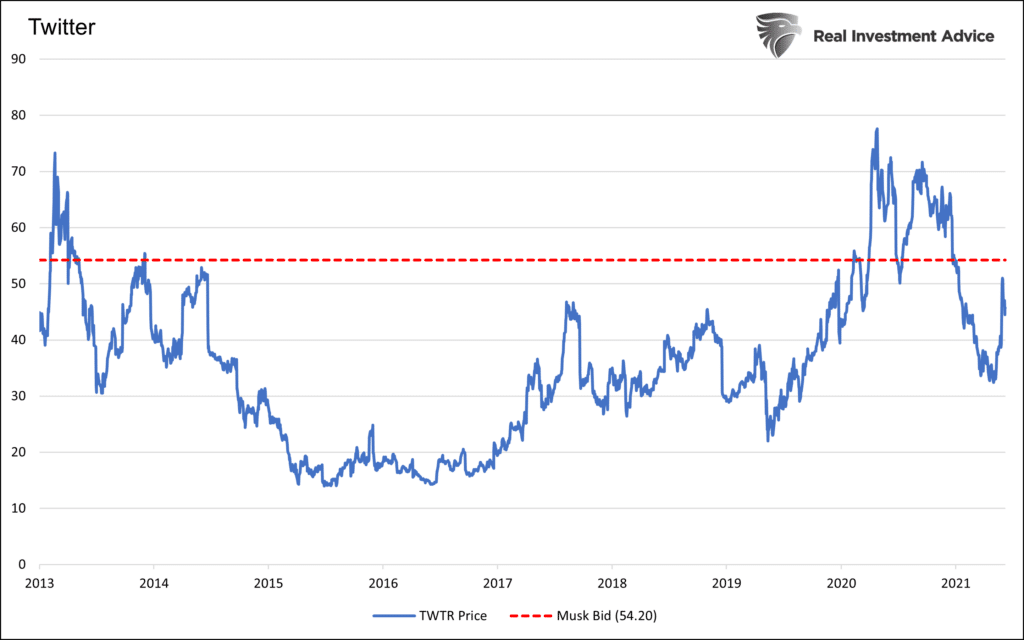

What To Watch Today
Economy
- 10:00 a.m. ET: NAHB Housing Market Index, April (77 expected, 79 in March)
Earnings
Pre-market
- Synchrony Financial (SYF) to report adjusted earnings of $1.54 on revenue of $2.70 billion
- Bank of New York Mellon Corp. (BK) to report adjusted earnings of 86 cents on revenue of $3.96 billion
- Bank of America (BAC) to report adjusted earnings of 74 cents on revenue of $23.24 billion
- Charles Schwab (SCHW) to report adjusted earnings of 84 cents on revenue of $4.81 billion
Post-market
- JB Hunt Transport Services (JBHT) to report adjusted earnings of $1.93 on revenue of $3.29 billion
Market Trading Update
In this past weekend’s newsletter we stated:
On Thursday, markets sold off, reversing the previous day’s gains as April options expiration led to a bout of volatility. The good news is that the market held support at the 50% Fibonacci retracement level even with the selloff. Furthermore, the market is oversold and close to triggering a short-term buy signal.
Given the oversold market condition and the fact the week after “tax day” trends positive as liquidations to pay tax bills complete, the odds for a reflexive rally are encouraging.
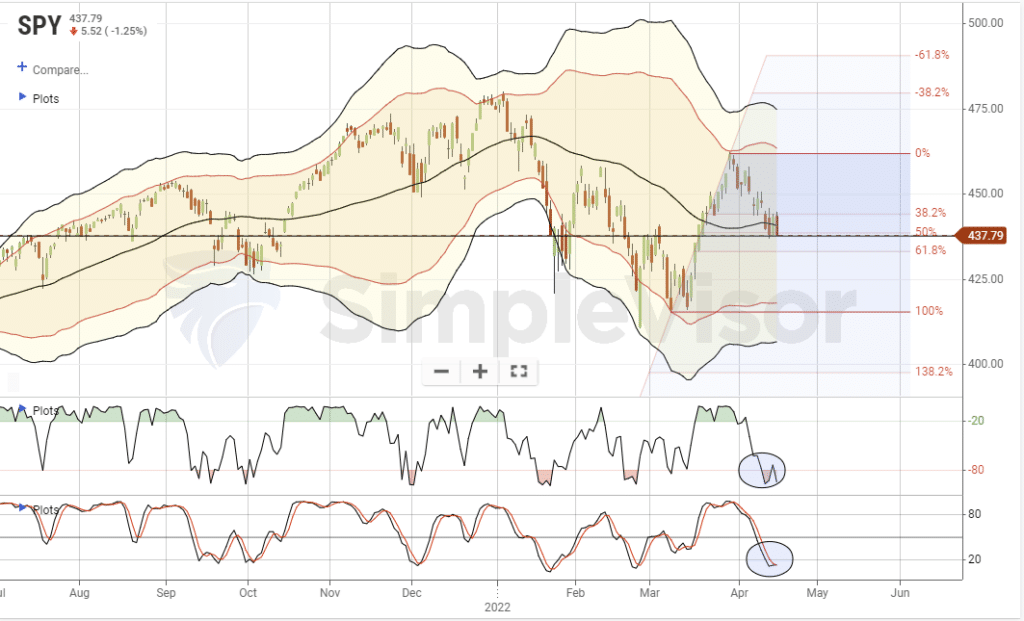
More On Tax Day Selling
Goldman Sachs via Zerohedge detailed my comments further:
“… but overall retail activity has been far more muted than in 2021, and as we noted last week, even retail flows finally turned negative as ‘the last market bull capitulated.’“
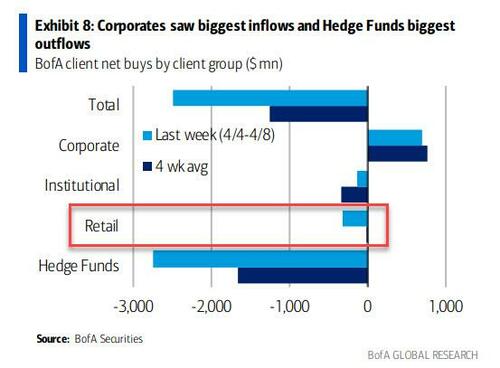
“What may have caused this recent reversal in retail sentiment? According to Goldman flow trader Scott Rubner, the answer is simple: taxes.
‘US equity market and 20x more exposure than hedge funds, and yet this largest owner of equities has slowed their trading activity ahead of April 18th tax deadline.
There is a record $2.14 Trillion worth of realized capital gains in 2021, which means a record capital gains tax bill of $346 Billion due on Monday. Putting it in context, this tax bill exceeds last year’s prior record of $270 Billion by 28%.
Such resembles trading activity from 2021, and because of that the bank is optimistic that we are about to see a resurgence in bullishness: ‘retail traders saw a resurgence on call option activity during the second half of April after taxes were paid.'”
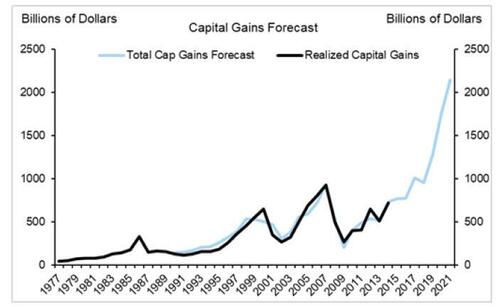
Twitter Performance – Meh
“In a letter publicly disclosed, Musk promised to “unlock” the “extraordinary potential” of Twitter. If talking financially, Musk has a point. Since its IPO in 2013 Twitter’s share price has mostly been below where it started. Slow user growth and a lack of user monetization (admittedly two things rivals Pinterest and SNAP have also contended with), has seen Twitter dramatically underperform Facebook (Meta).” – Chartr
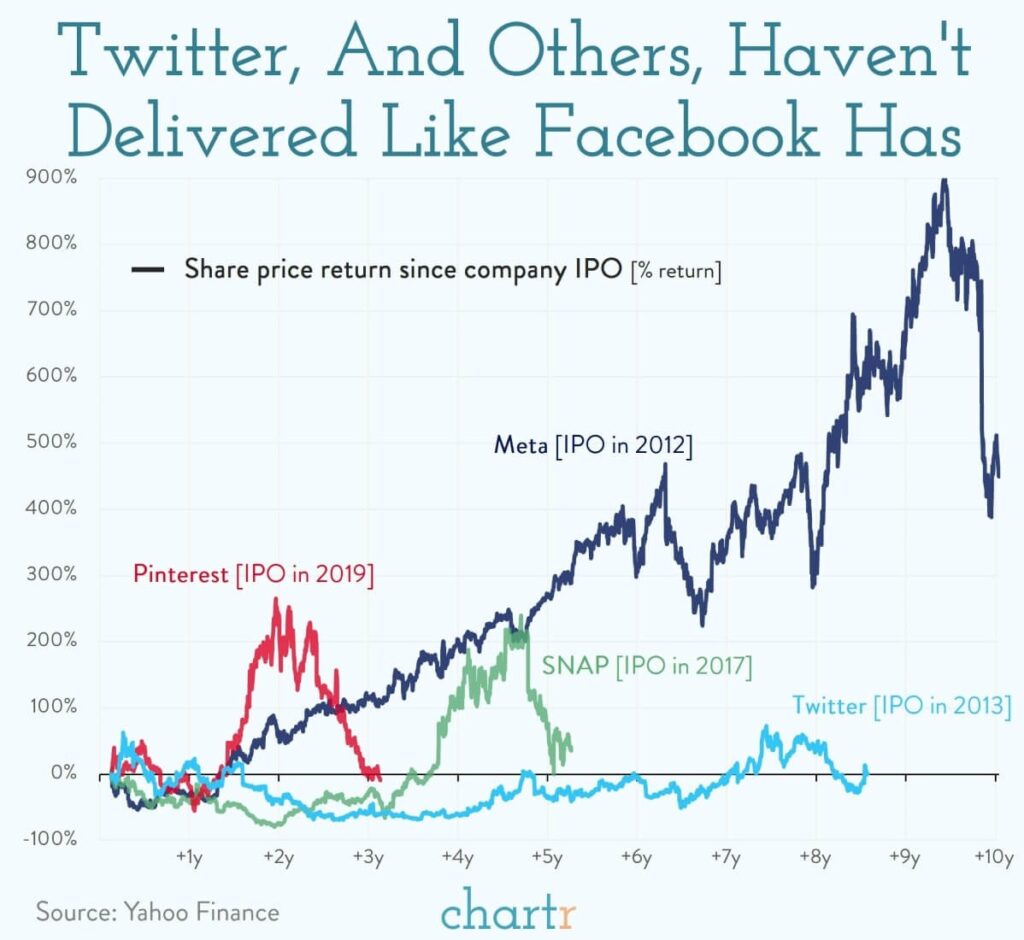
The Week Ahead
Economic data will be on the light side this week. Of interest will be a slew of housing data. Tuesday features data on new home construction, including housing starts and building permits. We suspect that both starts and permits will decline as sharply higher mortgage rates bite into the potential profit of new home builders. Existing home sale data will be released Wednesday. Thursday features our first glance at data for April with the Philadelphia Fed Manufacturing Index. The Index is a good proxy for the national ISM and PMI Manufacturing Survey due out later this month.
Corporate earnings releases will pick up this week. We will likely see a lot of price volatility as investors will gain more information on how well companies are handling inflation. This is the last week before the Fed goes into its self-imposed media blackout. Given they have widely alluded to a 50bps rate hike and QT, we do not think it is likely that any Fed speakers will rattle the markets with hawkish thoughts.
Retail Sales- Good on the Surface but Weak When Adjusted for Inflation
The headline Retail Sales data shows an increase of .5% in March. This is encouraging, given sharply higher prices for food and gas, the Russian invasion, and consumer sentiment is at decade lows. The bad news is that Retail Sales adjusted for inflation are weak. On Tuesday, the BLS reported that CPI rose 1.2% in March. As such, on a real (inflation-adjusted) basis, monthly Retail Sales fell by .7%. On an annual basis, Retail Sales are up 6.8%, but real Retail Sales are down 7.4%.
The graph below from EPB Macro Research helps put real Retail Sales data and trends in context. As the graph shows, the six-month annualized growth rate of .7% has been trending lower for a year and well below the longer-term 3% run rate.
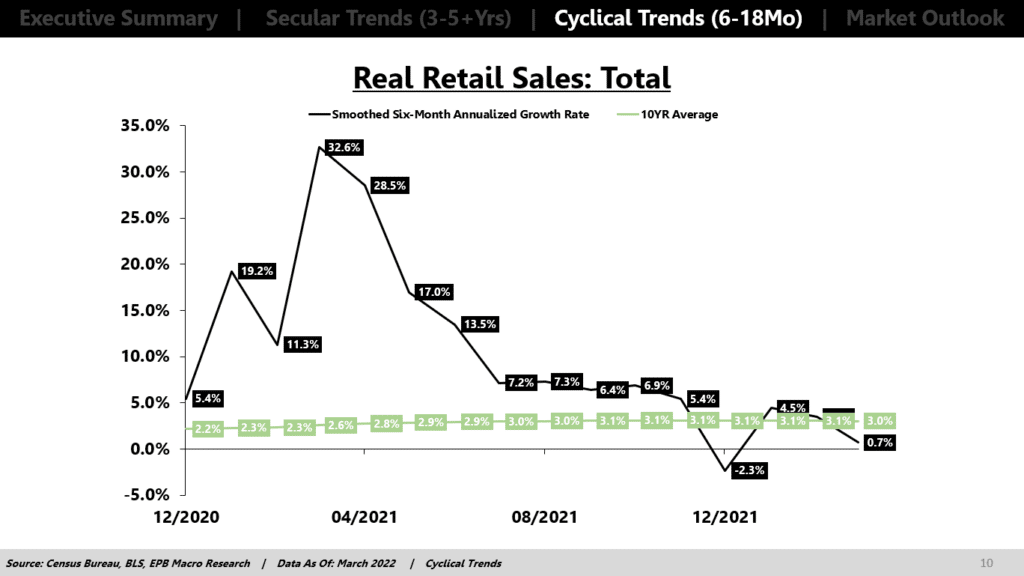
Now Bear Market for Utility Stocks
Despite weakness in most stocks and stock indexes this year, the graph below from Sentimentrader shows that Utility stocks are on a tear. Currently, over 50% of utility stocks in the index are at or very close to 52-week highs. That is the largest percentage in over 70 years. The graph of the Dow Jones Utility Index shows no signs of weakness as it too is at record highs.

Quote of the Day
Jim Grant’s quote below provides an excellent thought for what drives stock prices. He basically alludes that sentiment is more important than fundamentals. When the Fed pumps liquidity into markets, sentiment tends to run bullish. In those instances, valuations rise to rich levels as investors discount the value of fundamentals. The Fed is slowly starting to remove liquidity. Will fundamentals matter again?

Please subscribe to the daily commentary to receive these updates every morning before the opening bell.
Lance Roberts is a Chief Portfolio Strategist/Economist for RIA Advisors. He is also the host of “The Lance Roberts Podcast” and Chief Editor of the “Real Investment Advice” website and author of “Real Investment Daily” blog and “Real Investment Report“. Follow Lance on Facebook, Twitter, Linked-In and YouTube
Customer Relationship Summary (Form CRS)
Also Read



















